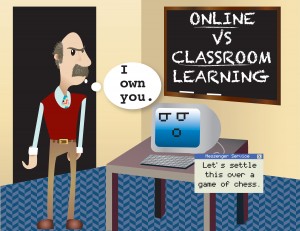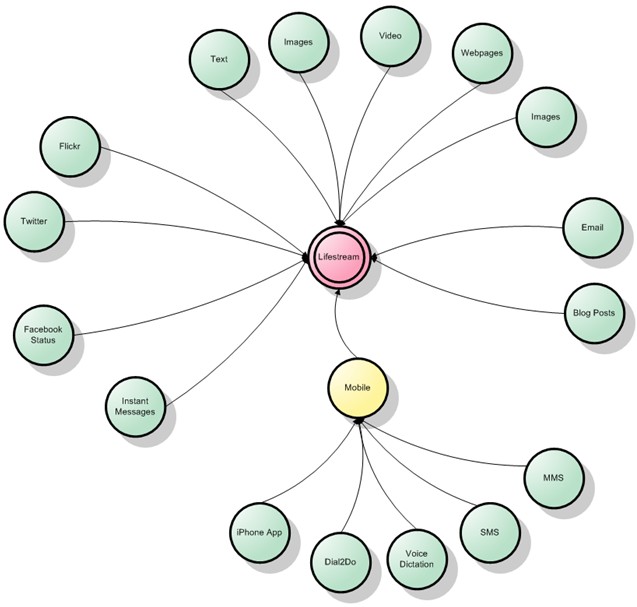
Ko & Rossen, Chapter 13: Teaching Web Enhanced and Blended Classes ↓
Some of the facts discussed in chapter 13 have already been mentioned throughout the book as put forward by the authors themselves but the specifics of blended classes are met here.
I don’t quite put myself in the category of teachers using a “little bit ” of the Web but I do use several Web features. There are some neat things I would like to try out in my classes this semester but considering the weekly time we have to teach our classes based on the departmental program, that we have to follow, I sometimes find myself limited as to use everything I see online as being interesting, fun and educational for a blended class.
But and as a matter of fact after discovering Personal Brain and Mindmeister just recently, I would like to suggest to my students to use either one for their next cultural assignment. So far, written and oral presentations have been done by my students using Prezi and the classical Power Point but I think that Personal Brain, Meindmeister and Map42 are great assets to be be explored by students.
♦Note: Even though we are in the XXIst century with what this implies in regards to technology, many students still shy away from the Web and rather stick to more conventional features such as Power Point because it seems safer.
I have a blog for my class and this semester no one is looking at it even for getting extra pts. So next semester, I will make it mandatory to bring some discussions forward. The subjects are based on cultural comparisons. I showed them some videos from the blog and ask them to present their viewpoints but the interest is lacking even if the videos are attractive, fun, colorful, etc. But it has not always been the case, though: some semesters were fantastic and the exchange of conversations was optimum.
In regards to lecturing, there is some of it, if we can call this lecturing: I do explain the grammatical points in class by using the digital book provided for the classes and sometimes the Power Point slides from the digital version. I really provide a mix of features for my onsite class: online quizzes through various Websites providing the answers, goanimate.com for creating short cartoons, exercises on paper done in groups and individually as well and discussing the answers together afterwards. Viewing of videos for oral comprehension oral assignments with the help of Power Point and Prezi.
Office hours as stated by Ko & Rossen are practically the office hours for invisible people: hardly anyone shows up except the students who need to make up a test…

1951: Before I was born!
Group projects are done in my classes also: some tests, cultural assignments via Turnitin in Blackboard, skits in class as oral presentations, Voice Boards or Wimba via Blackboard also. Their favorite are the group tests and usually the grades are higher when students do those kind of tests together. Sharing the information and giving the answers to specific questions make them happier for some reason! Time well spent.
R. Graham, J. Hilton, P. Rich, D. Wiley, Using Online Technologies to Extend a Classroom to Learners at a Distance ↓
 This was a lot of reading this week (!!!) and this article was interesting. I made the choice of commenting on a few results:
This was a lot of reading this week (!!!) and this article was interesting. I made the choice of commenting on a few results:
I agree with Wiley to stay away from Blackboard for distance learning since it is only open to students who are registered in the class via their school. Therefore, I also agree with him that WordPress, among other available blogs on the Web, would be the very best option since it is free also.
I noted the following from Wiley, which makes sense:
…”to avoid this system because there was no way to offer broader invitations to students to participate in a Blackboard-hosted course. The Blackboard system is designed in a way that prevents anyone who has not registered for the course from accessing any of the course materials or discussions. Wiley also chose to avoid Blackboard because even paying students who formally register for a course loose all access to course materials and discussions when the semester ends.” So true!
And again I agree:
“The main tool Wiley used in creating the space for his course was WordPress. WordPress is a free online tool that can be used to create blogs or websites. Using this tool he was able to create a course website that looked professional in one hour.” Yes, that’s true again.
I think that this article shows how well this course is designed and organized. Everything has its place where it should be: WordPress, Wiki, links. All well done so that an online class can also be used in an onsite class using the right and efficient technology.
I especially like this well thought out feature: “In addition to using WordPress, Wiley created a wiki in order to facilitate student participation in the course. Wiley wanted a separate place where students could add content to an unofficial course site. He created a wiki to facilitate this student participation, and provided a link from the official WordPress site to the wiki.” He just thought of everything.
Interesting to know that he was basically on his own (some type of Robinson Crusoe online): “While Wiley was free to use any tools he chose in supplementing his course, no support was provided for these tools by the university. Ample support was available, however, from the online communities of users of these tools.” Just to prove that online communities are the right ressources for an online and blended class as well. There is always help somewhere if you are looking.
“It must be noted that Wiley’s estimates of the time necessary to create these course components are from one who has a high level of technical proficiency. One of the authors of the present study, having significantly less technical expertise than Wiley found that to set up these course components took approximately fifteen hours.” Yes, certainly. I could not agree more. Just like Second Life: it takes quite some time to be good at it.
Conclusion from this article:
“Whether it is possible to facilitate strong learner-learner interactions with minimal effort on the part of the instructor, and impact this might have on students in the face-to-face classroom remains to be determined.” That’s the thing: all of this takes time to build and I am not sure about the minimal effort coming from the instructor at first. When it is your first online course, I believe it would take a good amount of time if you are not a pro at it yet. But as time goes by like anything else, I could eventually see less work for the instructor. Whether online or onsite in a blended class, it is a question of balancing your workload and still take the time to engage and facilitate a learner-learner interaction. All about knowing the in and out of a good class. How to be a good instructor. Basically.
Michael Wesch’s Digital Ethnography ↓
I very much liked the Youtube video on Digital Ethnography: perfect background music and typing away the words telling us about our connection to the Web because we, people, are the Web. I thought that this diagram below is also a good example of what is portrayed on the Web because we are making all those connections everyday on a keyboard, phone or computer. At least for those of us who are using the Internet every day. I was amazed at the speed following the cursor on this video showing us all the facts put together with the tags, the RSS feeds, the blog creation, etc. to ultimately tell us that we are the big Creators of all of this. Very good entrance to WWW.

George Siemen’s post on theory and MOOCs:
This is a very good video showing the principles of connected learning: I really liked the use of paper drawings in black and white; simple and very effective with the vocal explanation. The example (the paper student) just showed that by using everything available on the Web makes you smarter. You become a “learning sponge” so to speak. To become a XXIst century role student model (same for the teacher), you have to follow the flow and share what you know so you can learn from others and they learn from you. Connection to the world community on the Web. An infinite loop. The way to go.
I like the following comment from the article: “Learners need to create and share stuff – blogs, articles, images, videos, artifacts, etc. The maker movement embodies the “create stuff” attitude.” It is not just the teacher who is working but the student learner creates and shares his knowledge with all of us.

Even on top of a mountain, you need a computer….
Thank you again for your response, Cris!
For Second Life, I will wait a bit longer as I feel somewhat a bit (sometimes a lot) overwhelmed with work this semester. More classes than I anticipated.
My break will be after May 20th but going to France for 13 days (only!) on June 21st. I can’t wait! I need to rest!
I know that my cultural blog via NING so for free (http://flairfrancais.ning.com) will be different next semester: at least a few discussions / exchange of ideas will be mandatory instead of just for extra pts. so far.
If I don’t push them, the students don’t push themselves forward either because they rather stay static and they just go with the flow. More or less or not even with the flow!
Thank you again, Cris, and when the time is right, I will ask for your advice to start something basic with Second Life. It would be neat to get the students involved thanks to…you!
Have a good end of the week,
Danièle
Merci beaucoup, Rachèle: j’aime bien quand tu me fais des compliments, ah, ah!
C’est vrai que cette vidéo toute simple est vraiment bien et on comprend tout facilement avec ce petit bonhomme en papier. Mon cerveau a bien aimé toutes ces explications!
Bises et en route bientôt pour Potcert semaine 20…..
Danièle
Bravo Danièle! Un super post (comme d’hab). J’ai surtout aimé le tutoriel qui explique bien. C’est dingue comment une vidéo peut nous apprendre tant de choses. 😉
You are so kind with your encouragement, Danièle. I am learning to produce videos so to hear that I got my message across clearly and that my voice is dramatic enough to maintain interest will keep me motivated. Thank you!
You know, I’ve used student blogs in my classes for at least five years and have learned a lot from many others who have used them, but I’ve never heard about any problems with plagiarism. I think the key is to structure your blogging rubric so that, as in POTCERT, you expect your students to use the readings/resources as springboards for intellectual curiosity and critical reflection. Expect students to bring something new to the conversation — something that springs from their own personal experience and interaction with the course materials and, perhaps, from resources beyond that they either had previously discovered or were inspired by the course content to research further. Now that would be a big success, wouldn’t it.
Best of luck with your student blogging and with Second Life! Just let me know if I can ever help out with Second Life. Learning to teach in a virtual world is a real passion for me.
Thank you so much for your very nice comment!
Always trying to give a variety to each post but there is so much more to say. I am really getting engaged in those weekly posts, I have to admit. Looking forward to learn more and especially hoping to know how to use this new technology in a proficient way.
Another path to follow ahead of us.
Merci, Cris for your great input!
Yes, my students and similar students to mine do not see the need yet to become more proficient at blogging for educational purposes or know just a bit more about the “high tech” part of teaching online or an hybrid class.
And I watched your video today for week 19 and I thought that your approach was excellent. I also liked the sound of your voice: To me, it does “dramatize” the entire content (this is a very positive comment): it makes you want to keep listening until the end of the video. On a final note, you just summarize everything which needed to be known about sharing and connecting to the world. Very nice.
The only remark I would like to add is about a concern I have about sharing: wondering if some students would pick on others’ comments and take the credit for it by changing a few words for an assignment of their own. A bit like plagiarism. Perhaps it is a “normal” risk to consider.
Now I need to do just like you: not just being a fan of Second Life but being proficient at it too. I am not on the right path yet.
Thank you, Cris.
I had to smile and nod when I read about your somewhat technology-apathetic students, Danièle. I designed my grad course so there are two-week sessions and I begin each session with a blog post I call, “Travel Guide” (to extend my course’s journey metaphor). It’s basically a way to introduce the session in a bit more detail than the interactive syllabus and provide some tips based on what I’ve come to know of my students and their knowledge of the content and tools. Hey, just like Jim and Lisa do each week.
So when I realized that there was information in the Travel Guide that my students were missing out on — valuable information that would have saved them time in the long run — I included a question in the MidTerm Feedback Survey (anonymous) to see why they might not be reading the blog. The top reason was that they simply didn’t think they had the time to read it. Aaaarrrggghhhh!
I’m with you and Dave Wiley when it comes to the value of WordPress for a course. He must be quite technologically proficient to have set up his course in one hour. I can’t even begin to imagine how many hours I’ve put into mine and I was given the basic site all set up and ready to “populate.”
I think you’re wise to see the potential for opening up your course and inviting global participation. It would work perfectly with what it sounds like you do in Second Life. I’m also a huge Second Life fan and have enjoyed teaching there for almost seven years now. It works great for being able to invite guests, for being able to invite the world!
Hello, I have enjoyed reading your posts! I love the variety of media you use….pictures,links, videos. I enjoyed watching the video you posted showing the principles of connected learning. Learning from others, and others can learn from you…I like that motto! 🙂 I can see the importance of this to keep connected to the web community.